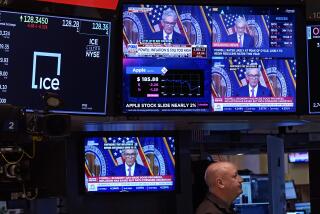Basic Money Supply Rises Sharp $9.9 Billion in Week
NEW YORK â The Federal Reserve Board said Thursday that its most basic measure of the U.S. money supply jumped $9.9 billion in late November. But it also reported less growth in two broader measures of money than most analysts had expected.
That news cheered the credit markets, where prices retraced some of the ground they lost earlier in the day.
Prices of some 30-year Treasury bonds, which had been down three quarters of a point before release of the money report, regained a quarter point to finish the day only a half point lower--about $5 for every $1,000 in face value. Short-term interest rates were unaffected by the report.
Analysts said the two broader money measures are now both within the central bankâs growth targets, diminishing chances that the Fed will find it necessary to tighten its credit policy. The targets were set to assure steady but non-inflationary economic growth.
The Fed said the measure of basic money supply, known as M1, rose to a seasonally adjusted $721.4 billion in the week ended Dec. 1 from a revised $711.5 billion the previous week, originally reported as $711.6 billion. M1 includes cash in circulation, deposits in checking accounts and non-bank travelers checks.
For the latest four weeks, M1 averaged $714.6 billion, a 15.2% seasonally adjusted annual rate of gain from the previous 13 weeks.
The Fed has said it would like to see M1 grow in a range of 3% to 8% from the fourth quarter of 1985 through the final quarter of 1986.
The Fedâs targets for the broader money measures known as M2 and M3 call for growth of 6% to 9%, and the latest growth figures left both below the upper target.
The central bank said M2, which is made up of M1 and such accounts as savings deposits and money-market mutual funds, rose $15.2 billion to $2.780 trillion in November. Economists surveyed before the reportâs release had predicted an increase of $17.2 billion.
The Fed said M3, which is the sum of M2 plus less liquid accounts such as certificates of deposit in minimum denominations of $100,000, rose $16 billion to $3.461 billion in November. The forecast of most economists had called for a rise of $18.6 billion.
âThis cools the fears that the Fed will tighten and gives the Fed latitude to ease,â said Raymond Stone, an economist for Merrill Lynch Capital Markets.
More to Read
Inside the business of entertainment
The Wide Shot brings you news, analysis and insights on everything from streaming wars to production â and what it all means for the future.
You may occasionally receive promotional content from the Los Angeles Times.










